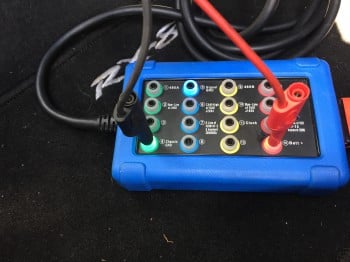Answer
Dec 02, 2016 - 07:02 AM

The connection of the Can Test Box to the 16 pin vehicle diagnostic connector provides a non-intrusive test point for all associated circuits, whilst LED’s will illuminate to indicate the status of the 16 pins. The 4mm banana sockets enable simple connection of PicoScope for circuit analysis, “jumper wires” for flash code interrogation, and on board “memory save” devices (During battery disconnection) With the pass-through connector and 2.5 meter cable, the Can Test Box can be used in series with your scan tool and remote from the 16 pin connector allowing for simultaneous scan tool and scope tests. (See below)
- Power and ground test for communication errors
- CAN HI CAN LOW activity (depending on manufacturer)
- Convenient “jumper wire” access point for flash code access or initialisation procedures
- Convenient point for “memory save” device connection
- Remote access to concealed 16 pin connectors via 2.5 meter cable
- Pass-through feature does not restrict scan tool access when connected
How does it work?
The CAN Test Box uses numbered backlit LEDs which illuminate when signal data is present on the corresponding pin of the DLC. Pulsing LEDs indicate signals being pulled high/low.
The LEDs indicate the following signals:
- LED 1/9 - 485A/485B (Manufacturer’s proprietary information)
- LED 2/10 - Bus+ Line J1850/Bus- Line J1850
- LED 3/8/12/13 - future upgrade
- LED 4 - Chassis GND (GROUND)
- LED 5 - Signal GND (SIGNAL)
- LED 6/14 - CAN High of SAE J2284/CAN Low of SAE J2284
- LED 7/15 K Line of ISO9141-2 and keyword 2000485A/L Line of ISO9141-2 and keyword 2000
- LED 11 - Clock
- LED 16 Batt+ (Voltage supply)
The CAN Test Box allows you to connect your PicoScope oscilloscope or any other compatible scope, enabling you to monitor any signals present such as the CAN High and Low signals. The CAN Test Box terminal pin ports are compatible with standard 4 mm jacks.
The CAN Test Box includes a 2.5 metre (8.2 feet) cable so that you can work in a convenient location away from the diagnostic connector, and an additional pass-through connector so that you can hook up your scan tool at the same time as your scope. The box is powered by the diagnostic connector, so no batteries or mains adaptor are needed.
Click to download Manual.






Add New Comment